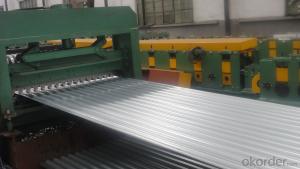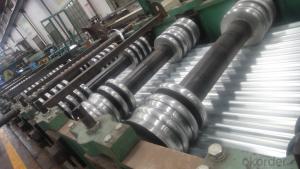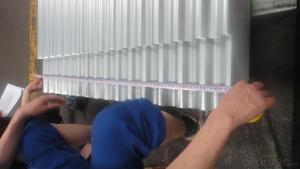0.12-1.2mm galvanized sheet price metal roofing material galvanized corrugated iron sheet
- Loading Port:
- Shanghai
- Payment Terms:
- TT OR LC
- Min Order Qty:
- 10 m.t.
- Supply Capability:
- 100000 m.t./month
OKorder Service Pledge
Quality Product, Order Online Tracking, Timely Delivery
OKorder Financial Service
Credit Rating, Credit Services, Credit Purchasing
You Might Also Like
0.12-1.2mm galvanized sheet price metal roofing material galvanized corrugated iron sheet
1> thickness: 0.12mm - 4.5mm
2> width:762mm/914mm/1200mm
3> length:Any length
4> basic material: Galvanized steel sheet, Aluzinc coated steel sheet, Aluminum steel sheet, Prepainted galvanized steel sheet, Prepainted aluzinc steel sheet
5> Zinc (Al) coating: 40g/m2 - 270g/m2
6> shape: corrugated/ trapezoid/Glazed
7> mainly usage: roof and wall
8> Package: standard export package or as customer's requirement
- Q:Are steel sheets suitable for cold storage applications?
- Cold storage applications can benefit from the use of steel sheets. Steel, known for its durability and strength, can withstand the low temperatures typically required for cold storage. This material is resistant to corrosion and does not absorb moisture, making it ideal for maintaining the cold air within the storage area. In addition, steel sheets are easy to clean and sanitize, ensuring the hygiene and safety of stored items. With excellent insulation properties, steel helps maintain a consistent temperature within the cold storage facility. Furthermore, steel sheets can be customized and fabricated to meet specific size and shape requirements for cold storage. In conclusion, steel sheets provide a reliable and practical solution for cold storage needs.
- Q:Can steel sheets be used for making shipping containers?
- Steel sheets are indeed suitable for the construction of shipping containers. In reality, steel is the preferred material for building shipping containers because of its robustness, durability, and ability to withstand diverse weather conditions and environmental elements. Typically, steel sheets are cut, bent, and welded together to create the walls, roof, and floor of the container. This construction technique guarantees the container's strength and ability to endure the challenges of transportation, such as stacking, lifting, and exposure to harsh marine environments. Moreover, steel containers can be easily tailored and adjusted to fulfill specific requirements for storing and transporting cargo.
- Q:How do steel sheets compare to other materials in terms of durability?
- Steel sheets are widely recognized for their exceptional durability compared to other materials. The unique properties of steel, such as its high tensile strength and resistance to corrosion, contribute to its long-lasting nature. Unlike materials like wood or plastic, steel sheets are not easily susceptible to wear and tear, making them a preferred choice for various applications that require durability. Steel sheets can withstand heavy loads without bending or warping, making them suitable for construction projects, automotive manufacturing, and industrial applications. Additionally, steel sheets have a longer lifespan compared to other materials, reducing the need for frequent replacements and maintenance. Overall, the durability of steel sheets is unmatched by many other materials, making them a reliable and cost-effective choice for many industries.
- Q:What is the typical thickness tolerance for steel sheets?
- The steel sheet thickness tolerance can vary depending on the specific industry and application requirements. Different industries or applications may have more stringent tolerance requirements, especially when precision is crucial. In such cases, the tolerance may be tighter. Specialized steel products or specific customer requirements may also lead to different tolerance specifications. Manufacturers employ strict quality control measures to ensure compliance with the desired thickness tolerance. These measures include precise calibration of equipment, regular inspection of raw materials, and comprehensive testing procedures. This helps maintain the integrity and reliability of steel sheets for various applications in industries such as automotive, construction, manufacturing, and more.
- Q:Can steel sheets be used for cladding or facades?
- Yes, steel sheets can be used for cladding or facades. Steel is a durable and versatile material that can provide strength, weather resistance, and aesthetic appeal to buildings. It can be shaped and customized to create different designs, textures, and finishes, making it a popular choice for cladding or facades in modern architecture.
- Q:Can steel sheets be used for heat exchangers?
- Yes, steel sheets can be used for heat exchangers. Steel is a commonly used material for heat exchangers due to its high thermal conductivity and durability. It can effectively transfer heat between fluids, making it suitable for various industrial applications.
- Q:What is the process of annealing steel sheets?
- Annealing steel sheets is a heat treatment process that involves heating the sheets to a specific temperature, typically above its recrystallization temperature, and then slowly cooling it down. This process helps to relieve internal stresses, soften the steel, and improve its ductility and machinability. The slow cooling allows the formation of larger grains, resulting in a more uniform and malleable material.
- Q:Are the steel sheets available in different thickness tolerances?
- Yes, steel sheets are available in different thickness tolerances.
- Q:What is the difference between a galvanized and aluminum steel sheet?
- The main difference between a galvanized steel sheet and an aluminum steel sheet lies in their composition and characteristics. Galvanized steel sheets are made from steel that has been coated with a layer of zinc, which helps to protect it from corrosion. This coating gives galvanized steel sheets a shiny, spangled appearance. On the other hand, aluminum steel sheets are made from aluminum alloy, which is naturally resistant to corrosion. Aluminum steel sheets are typically lighter and more malleable than galvanized steel sheets. Additionally, aluminum steel sheets have a duller, matte appearance compared to the shiny surface of galvanized steel sheets. Overall, the choice between galvanized and aluminum steel sheets depends on factors such as desired aesthetics, strength, corrosion resistance, and cost.
- Q:How are steel sheets protected during transportation by sea?
- To ensure the safety and prevent damage of steel sheets during transportation by sea, various measures are taken. One commonly used method involves applying a protective coating to the sheets. This coating acts as a barrier against moisture and saltwater, which are the main culprits behind corrosion during sea transportation. The coating can be a temporary solution, such as a layer of oil or wax, or a more permanent option, such as a layer of paint or zinc. Moreover, steel sheets are often bundled or placed in shipping containers for added protection. These bundles are secured with straps or wires to prevent movement and potential damage in rough sea conditions. The shipping containers themselves are designed to withstand the challenges of sea transportation and shield the steel sheets from exposure to the elements. Additionally, the sheets may be wrapped in plastic or other waterproof materials to provide an extra layer of defense against moisture. This helps prevent direct contact with seawater or rain, thus reducing the risk of corrosion. During the loading and unloading processes, proper handling techniques are employed to minimize the risk of damage. Cranes or forklifts are carefully used to lift and move the steel sheets, ensuring that they are not dropped or subjected to excessive force that could cause dents or bends. Overall, a combination of protective coatings, secure packaging, and proper handling techniques is utilized to safeguard steel sheets during sea transportation. This reduces the likelihood of damage and ensures that they reach their destination in optimal condition.
1. Manufacturer Overview |
|
|---|---|
| Location | |
| Year Established | |
| Annual Output Value | |
| Main Markets | |
| Company Certifications | |
2. Manufacturer Certificates |
|
|---|---|
| a) Certification Name | |
| Range | |
| Reference | |
| Validity Period | |
3. Manufacturer Capability |
|
|---|---|
| a)Trade Capacity | |
| Nearest Port | |
| Export Percentage | |
| No.of Employees in Trade Department | |
| Language Spoken: | |
| b)Factory Information | |
| Factory Size: | |
| No. of Production Lines | |
| Contract Manufacturing | |
| Product Price Range | |
Send your message to us
0.12-1.2mm galvanized sheet price metal roofing material galvanized corrugated iron sheet
- Loading Port:
- Shanghai
- Payment Terms:
- TT OR LC
- Min Order Qty:
- 10 m.t.
- Supply Capability:
- 100000 m.t./month
OKorder Service Pledge
Quality Product, Order Online Tracking, Timely Delivery
OKorder Financial Service
Credit Rating, Credit Services, Credit Purchasing
Similar products
New products
Hot products
Hot Searches
Related keywords






























